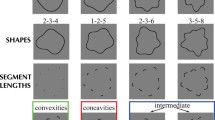Abstract
Shapes are a natural extension of lines and curves. In the simplest sense, a shape is just the enclosed space formed between three or more lines. Of course, a single continuous curve can enclose space as well (e.g., an ellipse). Shapes can be generally categorized. For example, an enclosed three-sided shape is referred to as a triangle, even if its size or configuration can’t be determined. Fundamental 2D shapes (e.g., rectangles, circles, and triangles) are commonly referred to as primitives. Primitives are essential building-block shapes, which when combined allow you to (efficiently) construct most other shapes. Processing includes both 2D and 3D primitive functions. In this chapter, you’ll just be dealing with 2D shape functions
Access this chapter
Tax calculation will be finalised at checkout
Purchases are for personal use only
Preview
Unable to display preview. Download preview PDF.
Similar content being viewed by others
Rights and permissions
Copyright information
© 2007 Ira Greenberg
About this chapter
Cite this chapter
(2007). Shapes. In: Processing. Apress. https://doi.org/10.1007/978-1-4302-0310-0_9
Download citation
DOI: https://doi.org/10.1007/978-1-4302-0310-0_9
Publisher Name: Apress
Print ISBN: 978-1-59059-617-3
Online ISBN: 978-1-4302-0310-0
eBook Packages: Professional and Applied ComputingProfessional and Applied Computing (R0)Apress Access Books




